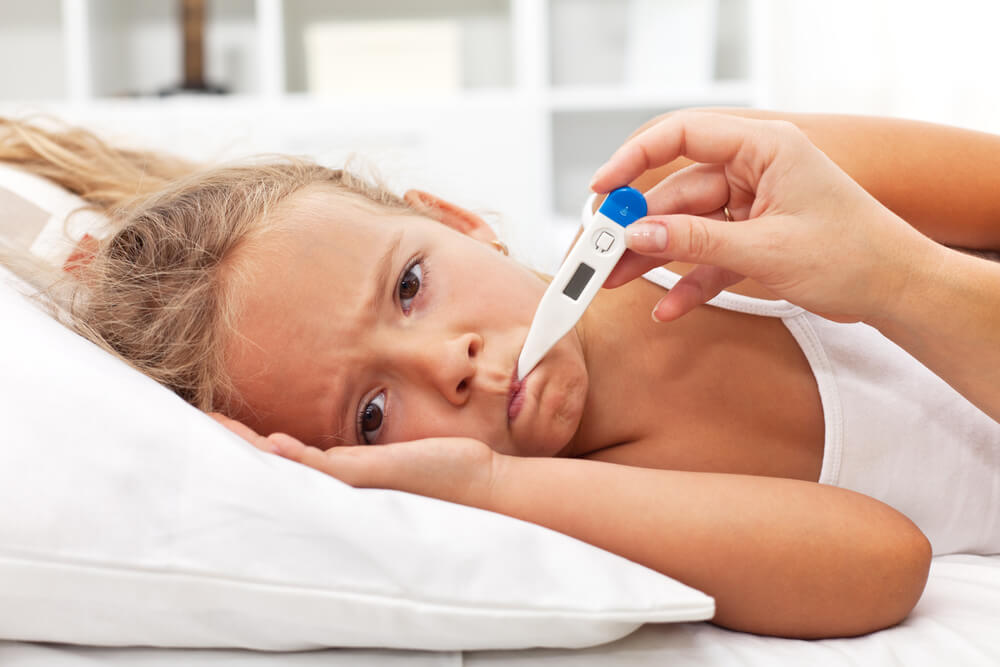In both adults and children, a fever is a sign that something is wrong in the body. It might indicate a minor cold or virus that someone in your home picked up at school or work, but it can also be a sign of something more serious. When your child has a high fever, you likely worry about what it means and what you should do. Learn what a fever might mean as well as what constitutes a high fever and when to see a doctor.
What Is a High Temperature?
The average temperature of the human body is 98.6 degrees Fahrenheit. You probably know at least one person who claims that they run hot or cold because their temperature is different. The temperature that you run depends on factors such as the amount of activity that you get every day, your body weight, and even your age. A child running a fever must have a body temperature of 100.4 degrees Fahrenheit or higher. You may not need to worry about getting to a doctor if your child runs a low fever.

Fever in Children When to Worry
As a parent, you likely worry about the health of your children. When your child runs a fever, you don’t need to rush right to the emergency room or spend all night concerned that you need to get to a doctor. One reason to see a child fever doctor is when your child runs a fever for more than five days and your child continues their normal activities. Fevers can indicate illness but can also relate to the temperature of your home and what your child does every day. If your child sleeps more than they did before and has a fever lasting more than five days, you should see a doctor as soon as possible.
For proper monitoring, make sure that you regularly take your child’s temperature and keep track of it. Head to the doctor if your child is between the ages of 3 months and 3 years and runs a fever of 102.5 degrees Fahrenheit or higher. Kids who are over the age of 3 years who have a fever of 103 degrees Fahrenheit or higher need to see a doctor. Keep in mind that a lower fever that lasts for 48 hours or less can occur if the child recently had a vaccination.
Common Causes of Fevers in Children
Parents often want to know when is a fever too high for children and what causes the fever. The ordinary cold is one of the more common causes of a fever, especially in kids. Kids can pass viruses around to each other in school and share germs that make each other sick. During cold and flu season, your child can develop the flu, which will often cause vomiting and other symptoms along with a fever.
Children suffering from chickenpox can run a fever, too. Your doctor will often look at your child’s symptoms and run tests to determine the cause of the fever. Certain infections can lead to your child running a fever as the body fights off the infection, including those that affect the ears and sinuses.
Taking Your Child’s Temperature
You have many options when it comes to taking your child’s temperature with thermometers designed for home use. A glass thermometer fits under the child’s arm, and you need to hold it in place for around three minutes. If your child is unhappy or active, you might find it hard to use this type. Other thermometers fit inside the ear and read the child’s temperature quickly. These are not always accurate, though, which is why you might want to verify that the temperature is accurate by using another thermometer and comparing the readings.
Using a digital thermometer is a good option for taking the temperature of an older child. Most of these thermometers slip under the tongue and provide a reading within a few seconds. A forehead thermometer is best for small children and those who can’t sit still. You simply scan across the forehead to get a reading, but you might find that the reading isn’t accurate.
There are also pacifier thermometers for babies and toddlers. If you want to know when to take child to doctor for fever, you should know that the best time is when a thermometer shows that your child has a high fever for several days or longer.
Don’t Fall Victim to Common Myths
Whether you’re a first-time parent or you have other children, you might fall victim to some of the common myths about a high fever in kids. One is that you can automatically tell if your child has a fever because they feel warm to the touch. Feeling warm to your hands can occur because the child was just running around and playing or wore several layers of clothing that day.
You might also think that all types of fevers are bad and that even a low-grade fever requires an immediate trip to the doctor. Unless your child has a high fever that lasts for multiple days, however, you generally do not need to worry. A fever will not cause brain damage unless it reaches 108 degrees Fahrenheit.

Before Seeing the Doctor
Before seeing a child fever doctor, you can treat the fever and some of the other symptoms that your child has at home. Both acetaminophen and ibuprofen can bring down a fever quickly, but ibuprofen is only suitable for kids over the age of 6 months.
Using a cold compress can also help. Dip a soft cloth in cool water and apply it to the child’s neck or chest. You can replace the cloth as it becomes warm. Kids running a high fever should also drink lots of fluids and wear layers that they can remove and add as needed.
Though you can give children cold and flu medication, stick to just one type and never mix and match over-the-counter remedies. Choose one designed for the age of your child. An old remedy claims that applying rubbing alcohol to the child’s chest can treat a fever, but this can make the fever run higher. The same thing happens with an ice bath, which can also worsen some of your child’s other symptoms. You can learn when a fever is too high for a child and what to do at home to help your child cope with a fever before getting to the doctor.
Keep Your Child Healthy
Worldwide Pediatrics Group knows the concerns that parents have about their children. When you discover that your child has a fever, you likely feel confused about what you should do and what it means. We can help you make an appointment to get in as soon as possible and give you advice on what to do at home. Need more information? Call today to learn how you can keep your child comfortable until your appointment.



